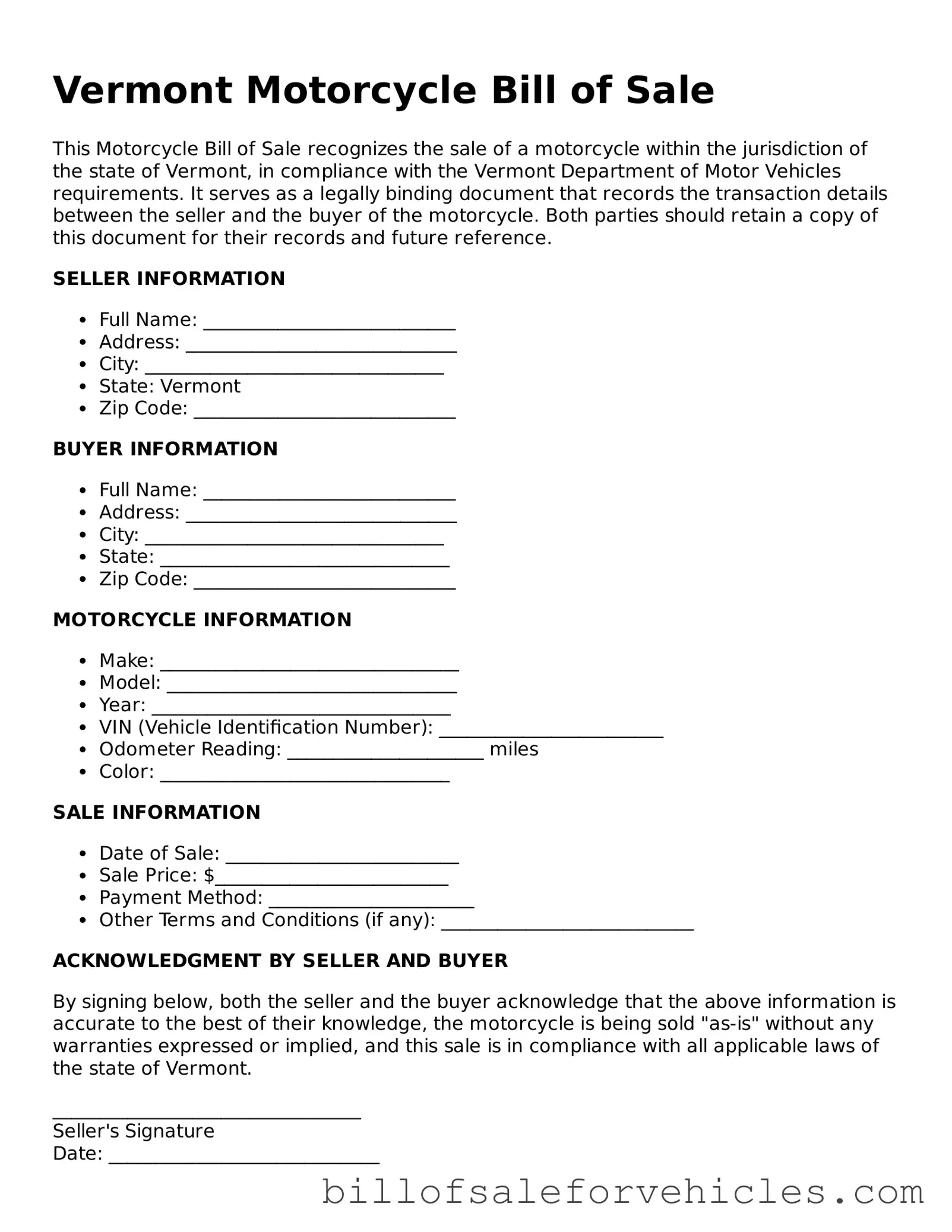What is a Vermont Motorcycle Bill of Sale form?
A Vermont Motorcycle Bill of Sale form is a legal document that records the sale of a motorcycle from one person to another within the state of Vermont. This form serves as evidence of the transaction, detailing the motorcycle's purchase price, the date of sale, and information about both the buyer and the seller. It is an essential step in transferring ownership and is required for the registration of the motorcycle under the new owner's name.
Why is it important to have a Vermont Motorcycle Bill of Sale?
Having a Vermont Motorcycle Bill of Sale is crucial because it legally documents the transfer of ownership. It protects both the buyer and the seller in case of disputes or misunderstandings about the sale. For the buyer, it serves as proof of purchase and ownership. For the seller, it provides evidence that they have relinquished their rights to the motorcycle. Additionally, it is necessary for the buyer to register the motorcycle in Vermont, as it shows the Department of Motor Vehicles (DMV) the transaction took place.
What information is typically included on a Vermont Motorcycle Bill of Sale?
The Vermont Motorcycle Bill of Sale typically includes the names and addresses of both the seller and the buyer, the sale date, the purchase price, and a detailed description of the motorcycle (make, model, year, VIN). It may also detail the odometer reading at the time of sale and any warranty information if applicable. Both parties are required to sign and date the form to validate the transaction.
Do I need to notarize the Vermont Motorcycle Bill of Sale?
While it is not a requirement in Vermont for a Motorcycle Bill of Sale to be notarized, doing so can add an extra layer of legal protection for both parties involved in the transaction. Notarization verifies the signatures on the document, helping prevent potential fraud or disputes in the future. However, it is advisable to check the most current requirements with the Vermont DMV or seek legal advice as procedures may change.
Can I create my own Vermont Motorcycle Bill of Sale form?
Yes, individuals can create their own Vermont Motorcycle Bill of Sale form. It must include all the necessary information about the transaction, the motorcycle, and the parties involved. While there are templates available, ensuring that the document contains accurate and comprehensive details is critical. However, it's recommended to use a professional or state-provided template when possible to guarantee that all legal requirements are met.
What should I do after completing a Vermont Motorcycle Bill of Sale?
After completing the Vermont Motorcycle Bill of Sale, the buyer should submit a copy to the Vermont DMV as part of the motorcycle registration process. Additionally, both the buyer and the seller should keep copies for their records. The document serves as proof of sale and ownership transfer, which can be crucial for tax reporting, resolving disputes, and as evidence in the event of theft or other issues.
Is a Vermont Motorcycle Bill of Sale the same as a title?
No, a Vermont Motorcycle Bill of Sale is not the same as a title. The Bill of Sale is a legal document that records the transaction and transfer of ownership between the buyer and seller. A title is a legal document issued by the state that officially recognizes the owner of the vehicle. While the Bill of Sale is necessary for the process, the title transfer needs to be completed separately to legally document the ownership change with the Vermont DMV.
